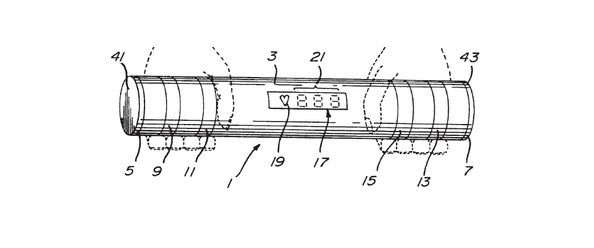On April 27, 2015, the CAFC decided (again) that the “spaced relationship” phrase “informs those skilled in the art about the scope of the invention with reasonable certainty.” Biosig’s claims that include that phrase comply with Section 112 ¶2.
Claim 1 of U.S. Pat. No. 5,337,753 is representative and recites, in relevant part:
1. A heart rate monitor for use by a user in association with exercise apparatus and/or exercise procedures, comprising: an elongate member; electronic circuitry including a difference amplifier having a first input terminal of a first polarity and a second input terminal of a second polarity opposite to said first polarity; said elongate member comprising a first half and a second half; a first live electrode and a first common electrode mounted on said first half in spaced relationship with each other; a second live electrode and a second common electrode mounted on said second half in spaced relationship with each other; said first and second common electrodes being connected to each other and to a point of common potential . . .
Fig. 1 of the ‘753 patent shows the first live electrode 9 is in a spaced relationship with the first common electrode 11 and the second live electrode 13 is in a spaced relationship with the common electrode 15.
The background of this case touches all levels of the federal court system. In 2013, applying the “insolubly ambiguous” standard the CAFC held that “spaced relationship” is not indefinite. Citing precedent, the CAFC stated that a claim is indefinite “only when it is ‘not amenable to construction’ or ‘insolubly ambiguous.'” Nautilus I, 715 F.3d at 898 (quoting Datamize, LLC v. Plumtree Software, Inc., 417 F.3d 1342, 1347 (Fed. Cir. 2005)). Under that standard, the CAFC determined the ‘753 patent survived indefiniteness review. The Supreme Court granted certiorari and vacated the judgment of the CAFC and remanded the case.
The Court found the “insolubly ambiguous” standard too imprecise and articulated the standard to be applied: “[W]e hold that a patent is invalid for indefiniteness if its claims, read in light of the specification delineating the patent, and the prosecution history, fail to inform, with reasonable certainty those skilled in the art about the scope of the invention.”
Judge Wallach remarked that as a result of the Court’s decision “we may now steer by the bright star of ‘reasonable certainty,’ rather than the unreliable compass of “insoluble ambiguity.”
The CAFC reiterated that when a “word of degree” is used, the court must determine whether the patent provides “some standard for measuring that degree” and that terms of degree are not “inherently indefinite.” Claim language employing terms of degree has long been found definite where it provided enough certainty to one of skill in the art when read in the context of the invention.” Interval Licensing v. AOL, 766 F.3d 1364, 1370 (Fed. Cir. 2014). Moreover, when a claim limitation is defined in “purely functional terms,” a determination of whether the limitation is sufficiently definite is “highly dependent on context (e.g., the disclosure in the specification and the knowledge of a person of ordinary skill in the relevant art area).” Halliburton Energy Servs., Inc. v. M-I LLC, 514 F.3d 1244, 1255 (Fed. Cir. 2008).
Using intrinsic evidence (considering the Teva Pharmaceuticals USA v. Sandoz (SC 2015) and the Enzo Biochem Inc. v. Applera Corp. (Fed. Cir. 2015) decisions) the CAFC stated that the claim language, specification and the figures illustrate the spaced relationship between the live and common electrodes are telling and provide sufficient clarity to skilled artisans as to the bounds of this disputed term.
The decision concludes with: “[i]n this case, a skilled artisan would understand the inherent parameters of the invention as provided in the intrinsic evidence. The term “spaced relationship” does not run afoul of “the innovation-discouraging ‘zone of uncertainty’ against which [the Supreme Court] has warned,” and to the contrary, informs a skilled artisan with reasonable certainty of the scope of the claim. Interval Licensing, 766 F.3d at 1374 (quoting Nautilus II, 134 S. Ct. at 2130). Accordingly ,the 2015 CAFC decision reaches the same ultimate conclusion of indefinites of Biosig’s claims using a different standard.


Recent Comments